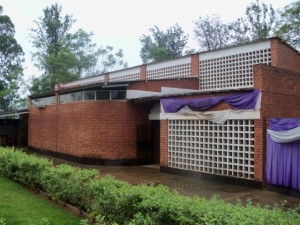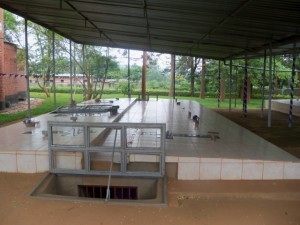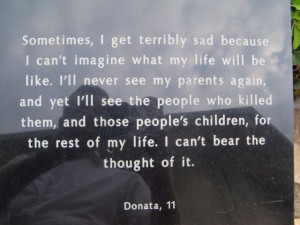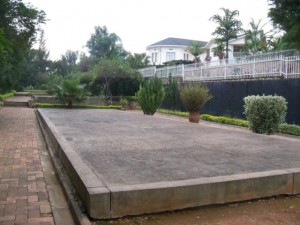“Over 10,000 people were killed in and around this church,” said Anita as she gave us the tour of the Nyamata genocide memorial.
Nyamata is the Catholic Church some 30 minutes from Kigali where the genocide started. Anita was 12 at the time and somehow was able to get up in a tree and hide. She explained that the church was crammed full of people. They have locked themselves in for protection, but the genocidaires used a bomb to blow the door open. They then went in and killed everyone using guns, clubs, machetes and spears, even just smashing heads of small children against the church walls. In this memorial now the church has been left as it was after the people were buried. The benches are piled with the clothes of the victims, piled. One section in the back has the clothes of the children. You can see the blood stains on the church walls. The white altar covering is stained with blood. There are bullet holes in the roof and marks on the brick walls.
In a kind of mausoleum under the main floor are many skeletons in a glass case, shelves of skulls on which you can see the kind of injury they died from.
Over 45,000 people are buried in mass graves outside behind the church. Again you can walk down inside and see shelves of bones, entire shelves 3 ft by 4 ft holding skulls.
Back in Kigali we went to the Kigali Genocide Museum and memorial. Excellent. A must visit in Kigali. The museum describes what took place over the course of decades which in essence prepared the way for the genocide. As I remember it, starting back in the 1920s the colonial government began to separate the Hutus from the Tutsis, initially based on who has how many cattle. About 85% of the population were called Hutus and 15% Tutsis. Later a Belgian began to distinguish them according to genetic features. These were solidified and taught. The colonial administration played the two groups off against each other as a means of control. Starting in 1959 there were several massacres of Tutsis. If I remember correctly there was one per year in the 4-5 years before 1994 when the genocide started.
As I wrote in my blog about reconciliation, in the years before 1994 the Rwandan government was systematically teaching that the problem with the country was the Tutsis. A group of Hutu extremists were formed and trained to eliminate the Tutsis. There were taught to kill. Incredible.
The genocide started after the death of Rwandan President Juvénal Habyarimana in a plane crash on April 6, 1994. President Habyarimana was returning to Kigali with President Cyprien Ntaryamira of Burundi when their plane was shot down by a missile. The plane crashed right outside and into the President’s residence with both their bodies ending up inside the walls of the compound. The radio started to broadcast that the Tutsis had done this and retribution needed to be taken. And the killing started. It went on and on and on. 10,000 people were killed per day for 100 days. Uncomprehendable the evil man can do to his fellow man. For more information on the genocide refer to Rwanda genocide on Wikipaedia.
The museum describes the atrocities committed, has testimonies from children and adults who survived, many wondering “why me?”, and the aftermath which will impact Rwanda for generations as the country bears the physical and psychological scars of the genocide. The museum also has a recently added section on the history of genocide which includes the stories of the Germans and the Hereo people in Namibia, the Turks and the Armenians, Pol Pot and Khmer Rouge, the Holocaust, the Serbs in Serbia and Bosnia and Herzegovina and more. These presentations were all well done.
It is an overwhelming and sobering experience to visit the memorials, see the mass graves and the skulls. I think about the horrible things that man has done to man over the centuries, and the stories here are only a small part of that ugly history, and I shake my head as I ponder how could we do that to each other, and not just once, but over and over again. I know the answer–sin. Thanks be to God for His amazing grace that saved a wretch like me, that saved wretches like us. And then I remember the stories of the reconciliation village and other stories I’ve heard where reconciliation has been lived out, and I give thanks to the Lord for the miracle of His grace. My prayer is that more and more of the Rwandan people woudl experience reconciliation and sense God’s presence in their lives.





Thanks for this post. I like it!
Report This Comment